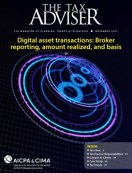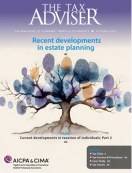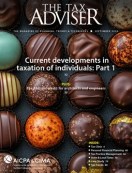- tax clinic
- credits against tax
R&D tax credits: A new era of disclosure and documentation
Related
Notice 2025-27 provides interim guidance on corporate AMT
Two Tax Court rulings expose overvalued conservation easements
Late election relief in recent IRS letter rulings
Editor: Jessica L. Jeane, J.D.
The Sec. 41 research–and–development (R&D) tax credit has long served as a vital incentive for U.S. businesses to invest in innovation. Yet, as the credit has matured, so, too, has scrutiny. Recent IRS guidance, increased compliance requirements, and court decisions such as Harper,847 Fed. App’x 408 (9th Cir. 2021), and Premier Tech, Inc.,No. 2:20–cv–890 (D. Utah 7/15/22), have redefined what it means to file a defensible R&D credit claim. The 2024 update to Form 6765, Credit for Increasing Research Activities, formalizes a shift toward transparency, documentation, and upfront substantiation. This item explores the evolving balance of risk and reward surrounding the R&D credit in light of these developments.
The Harper decision: A precursor to formalized disclosure standards
The Ninth Circuit’s decision in Harper revealed a significant disconnect between R&D filers and IRS documentation standards in the R&D refund claim process: the risk of IRS procedural objections when filings lack specificity. In that case, Jeffrey Harper, the sole shareholder of Harper Construction Co., submitted refund claims supported by over 100,000 pages of documentation. The IRS conducted a four–year audit but later moved to dismiss the claim, arguing the original Form 6765 lacked the detail required under Regs. Sec. 301.6402–2(b)(1), which provides that “[t]he claim must set forth in detail each ground upon which a credit or refund is claimed and facts sufficient to apprise the Commissioner of the exact basis thereof.”
Although the district court had sided with the IRS that the claim did not set forth in detail the basis for the claim (Harper, No. 18cv2110 DMS (S.D. Calif. 4/25/19)), the Ninth Circuit reversed, holding that the IRS had waived its procedural objection by accepting a properly filed Form 6765 and auditing the claim over a four–year period. The court emphasized that once the IRS engages with the content of a claim, it cannot retroactively assert that the claim was insufficiently specific.
While Harper ultimately prevailed, the case underscored a broader issue: Taxpayers cannot expect IRS audit action to validate claims that are procedurally weak at filing. The dispute was not over the merits of the research but over form and procedure — highlighting the need for upfront clarity, with the IRS revamping the Form 6765, forcing taxpayers to disclose further information at the time of filing. That logic became foundational in shaping the IRS’s evolving expectations for R&D credit disclosures. If vague or incomplete filings could derail claims, the Service’s response was to formalize what “sufficient detail” looks like.
The Premier Tech decision: The procedural hurdle
If Harper revealed the risks of refund claims lacking clear documentation, Premier Tech showed that even properly filed claims — when lacking project–level specificity — could face procedural rejection, further underscoring the IRS’s shift toward standardized front–end disclosure. In Premier Tech, the taxpayer, Premier Tech Inc., filed an amended return seeking a refund for the R&D tax credit, including a completed Form 6765 that outlined wages and supply costs. While the calculations were clearly presented and the nature of the credit was disclosed, the IRS challenged the filing, arguing it lacked sufficient specificity under Regs. Sec. 301.6402–2(b)(1).
The government argued that Premier’s claim did not explicitly detail the research performed, the components developed, or the wages and supplies tied to specific projects, elements that are not required on Form 6765. Ultimately, the court sided with Premier Tech, holding that its amended return and Form 6765 provided enough information to constitute a valid administrative claim. Still, the case underscored a key trend: The IRS is increasingly focused on upfront documentation and specificity, even when taxpayers follow the existing form instructions.
The broader implication of Premier Tech is clear: While the taxpayer ultimately prevailed on the government’s motion to dismiss for failure to state a claim upon which relief could be granted, the litigation spotlighted the IRS’s appetite for procedural challenges and the risk that refund claims, especially those submitted on amended returns, could be rejected for not providing what the IRS considers sufficient detail. This tension set the stage for IRS News Release IR–2021–203 and the subsequent evolution of Form 6765 into a more narrative–driven compliance tool.
IR-2021-203 and the June 2024 update: New requirements for refund claims
In October 2021, the IRS cemented its expectations in News Release IR–2021–203, which outlined the new prerequisites for R&D credit refund claims. Effective for claims filed after Jan. 10, 2022, the IRS initially required five essential elements:
- Identification of all business components to which the claim relates;
- Description of research activities for each component;
- Names of individuals who performed each activity;
- Information each individual sought to discover; and
- Total qualified employee wage, supply, and contract research expenses for the claim year.
However, as of June 18, 2024, the IRS issued an important update on its webpage “IRS Sets Forth Required Information for a Valid Research Credit Claim for Refund.”In FAQ 21, the IRS announced that it is waiving the requirement to provide the following two elements at the time a refund claim is filed:
- The names of individuals who performed each research activity; and
- The information each individual sought to discover.
Taxpayers are still required to provide:
- Identification of all business components related to the credit;
- Description of research activities performed for each component; and
- Total qualified employee wage, supply, and contract research expenses, which may be reported on Form 6765.
While the two waived elements are no longer required at the time of filing, the IRS may request them during an audit or examination. This update provides some administrative relief but does not eliminate the need for thorough documentation.
Walking through the four-part test
With the foundation laid by News Release IR–2021–203 and reinforced by the June 2024 update, the IRS has clearly signaled a shift toward greater upfront transparency in R&D credit claims. These changes are not merely administrative; they reflect a broader reinterpretation of what it means to satisfy the statutory requirements of Sec. 41. By narrowing in on key elements, such as identifying business components, explaining research activity, and disclosing related costs, the IRS is effectively reframing the four–part test under Sec. 41(d) through a more streamlined, compliance–oriented lens.
What this suggests is that taxpayers must go beyond simply meeting the letter of the law. They must now articulate their compliance in a format the IRS can immediately assess. The evolution of Form 6765 exemplifies this with the inclusion of information that seeks to answer such pragmatic questions as what taxpayers make, why it is qualified, and its cost. Practitioners who build their documentation and project narratives around these three inquiries will be better equipped to withstand IRS scrutiny while aligning with current disclosure expectations.
To qualify under Sec. 41(d), research activities must meet the four–part test:
- Sec. 174 test: The activity must involve expenditures eligible to be treated as research or experimental under Sec. 174. This means it is undertaken to resolve uncertainty related to the development or improvement of a product or process and occurs within the taxpayer’s trade or business.
- Technological in nature: The research must rely on hard sciences, such as engineering, computer science, biological science, or physical science.
- Business component test: The activity must aim to develop or improve a business component — broadly defined as any product, process, software, technique, formula, or invention used in the taxpayer’s trade or business or held for sale, lease, or license.
- Process of experimentation: Substantially all of the research activities must be part of a systematic process designed to evaluate alternatives or eliminate uncertainty related to capability, method, or appropriate design. This may include modeling, simulation, prototyping, or other forms of trial and error.
Yet, in practice, the IRS has distilled these into three pragmatic inquiries:
- What did you make? Identification of the business component and whether it is held for sale, license, lease, or internal use.
- Why is it qualified? Explanation of technical uncertainty and experimentation.
- How much did it cost? Breakdown of project-level costing.
This simplified lens aligns with the new Form 6765 structure, pushing for clearer project narratives.
Industry focus: Where the scrutiny lies
While R&D activities span multiple sectors, the IRS has maintained heightened scrutiny on specific industries:
- Manufacturing: Especially tooling, prototyping, and custom fabrication;
- Architecture and engineering (A&E): Frequently challenged due to dual-function activities that blend innovation with standard design; and
- Software development: Facing increasing pressure to delineate between qualified development and routine maintenance and development that does not require a process of experimentation to eliminate uncertainty at the onset of the development.
The more an industry tends to use cross–functional teams and agile workflows, the more important it becomes to maintain detailed contemporaneous documentation that separates qualifying R&D from nonqualified activities.
The need for project-level cost accounting
More than ever, calculating the R&D credit demands rigorous cost tracking. Taxpayers must not only prove what they did and why it qualifies but also how much it costs on a per–project basis. This often requires collaboration among finance, engineering, and operations to establish time–tracking systems, project codes, and indirect cost allocations.
Without these systems, companies risk:
- Underclaiming the credit by omitting eligible expenses;
- Overclaiming it and facing audit risk; and
- Missing the new substantiation thresholds built into Form 6765.
This is especially important for A&E firms and manufacturing companies, where labor hours are often spread across both qualified and nonqualified activities.
A proactive compliance commitment
The R&D credit remains one of the most valuable incentives for companies investing in innovation, but the rules and expectations have evolved. Harper demonstrated the procedural risks of vague or insufficient refund claims, while Premier Tech reinforced how even standard filings may fall short without clear supporting detail. Together, these cases helped shape the IRS’s shift toward formalized disclosure, now embedded in News Release IR–2021–203 and the redesigned Form 6765. Today’s Form 6765 is more than just a form; it’s a high–level narrative of a company’s R&D journey. Supporting documentation, including detailed project descriptions and contemporaneous records, has become critical, not just for audit defense but for establishing claim validity at the outset.
For tax professionals, the message is clear: Treat R&D tax credit planning as an ongoing, integrated process supported by clear communication across departments; detailed contemporaneous records; and proactive, transparent reporting. In today’s environment, the real risk is not in claiming the credit, it is in claiming it without a clear, documented road map.
Editor
Jessica L. Jeane, J.D., is director of tax policy, national tax, with Baker Tilly in McLean, Va.
For additional information about these items, contact Jeane at Jessica.Jeane@bakertilly.com.
Contributors are members of or associated with Baker Tilly.
Baker Tilly US, LLP, and Baker Tilly Advisory Group, LP, and its subsidiary entities provide professional services through an alternative practice structure in accordance with the AICPA Code of Professional Conduct and applicable laws, regulations, and professional standards. Baker Tilly US, LLP, is a licensed independent CPA firm that provides attest services to clients. Baker Tilly Advisory Group, LP, and its subsidiary entities provide tax and business advisory services to their clients. Baker Tilly Advisory Group, LP, and its subsidiary entities are not licensed CPA firms.














